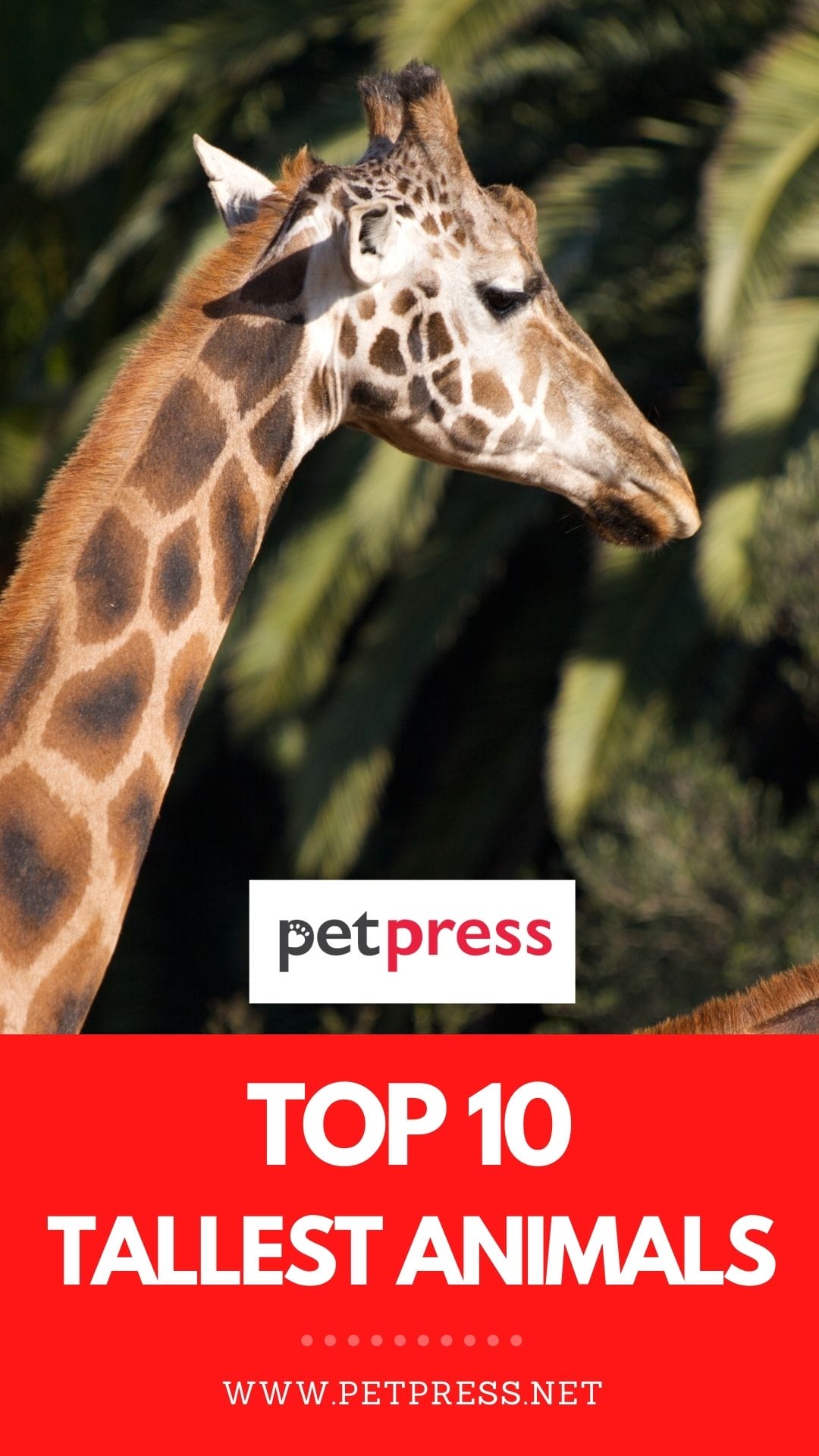
From the sprawling savannas of Africa to the dense forests of Asia, the animal kingdom boasts creatures of incredible size and diversity.
But who reigns supreme in the realm of height?
Today, we’re embarking on a journey to discover the Top 10 Tallest Animals on Land in the world!
Get ready to be amazed by towering giants, fascinating adaptations, and surprising contenders for the crown.
Buckle up, animal enthusiasts, because we’re about to explore a world where the view from the top is truly breathtaking!
1 – Amur Tigers (Siberian Tiger)

With their population plummeting by 95 percent in the last one hundred years, there are only around 4,000 of these tigers remaining today and they are a joy to see while they survive!
They have a shoulder height of around 0.76-1m (2’5″-3’5″), and while they aren’t the tallest creature on Earth, they are one of the most dangerous predators!
In the wild, they typically live around 10 to 15 years and up to 20 in captivity.
Detailed Overview
| Attribute | Description |
| Scientific Name |
Panthera tigris altaica
|
| Common Name |
Amur Tiger (Siberian Tiger)
|
| Habitat |
Primarily found in the Russian Far East, including forests, mountains, and taiga ecosystems
|
| Conservation Status | Endangered |
| Population |
Estimated to be around 540-800 individuals in the wild (as of 2022)
|
| Size |
Largest of all tiger subspecies, males can weigh between 180-306 kg (400-675 lbs) and measure up to 3.3 meters (11 feet) in length from head to tail
|
| Diet |
Carnivorous, primarily hunting ungulates such as deer, wild boar, and elk, but also preying on smaller mammals, fish, and occasionally birds
|
| Behavior |
Solitary animals, with males having large home ranges overlapping with several female territories. They are primarily nocturnal and solitary hunters.
|
| Reproduction |
Mating can occur throughout the year, with a gestation period of approximately 3.5 months. Females give birth to litters of 2-4 cubs on average.
|
| Threats |
Habitat loss and fragmentation, poaching for their fur and body parts, and human-tiger conflict are significant threats to Amur Tigers.
|
| Conservation Efforts |
Conservation efforts include habitat protection, anti-poaching measures, and captive breeding programs aimed at increasing wild populations.
|
| Unique Features |
Amur Tigers have thick fur coats and a layer of fat to withstand harsh winters. They are also known for their distinctive reddish-orange fur and black stripes, which provide excellent camouflage in their forest habitat.
|
2 – Grevy’s Zebra
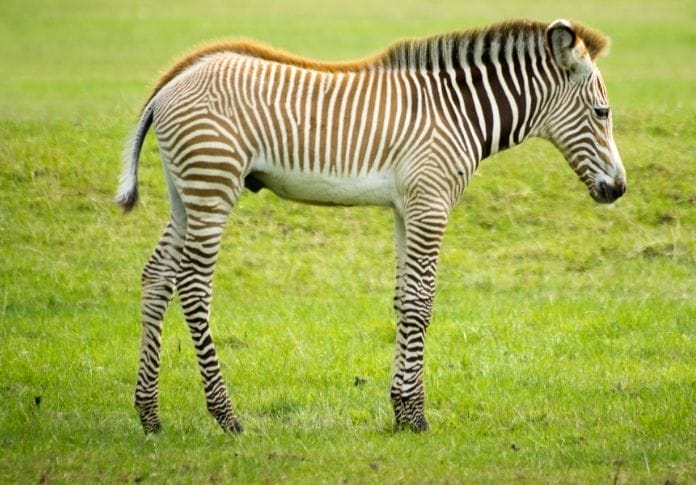
With stripes that can dazzle predators, zebras are a highly endangered species.
Zebra foals may be recognized by distinctive markings on their forehead and hind legs; the horn-like curving line called a “gingham stripe” covers the top of their head.
They are also the tallest of the three zebra breeds, standing around 1.2–1.52m (4′-5″) tall at the shoulder.
In the wild, they have a 25-year lifespan, but in captivity, they can live up to 30 years.
Related: 200+ Best Zebra Names
Detailed Overview
| Characteristic | Description |
| Scientific Name | Equus grevyi |
| Habitat |
Semi-arid grasslands, savannas, and scrublands of East Africa
|
| Conservation Status | Endangered |
|
Physical Description
|
– Largest of all wild equids
|
|
– Vertical stripes on body, narrower and closer together than other zebra species
|
|
|
– Large, round ears
|
|
|
– White belly and muzzle
|
|
|
– Black and white stripes extend to hooves
|
|
|
Behavior
|
– Solitary or in small groups
|
|
– Males establish territories and defend them vigorously
|
|
|
– Primarily diurnal (active during the day)
|
|
| Diet |
Herbivorous, feeding primarily on grasses and other vegetation
|
|
Reproduction
|
– Gestation period of around 13 months
|
|
– Typically gives birth to a single foal
|
|
|
Threats
|
– Habitat loss and fragmentation
|
|
– Competition with livestock for resources
|
|
|
– Poaching for their skins and meat
|
3 – Polar Bear
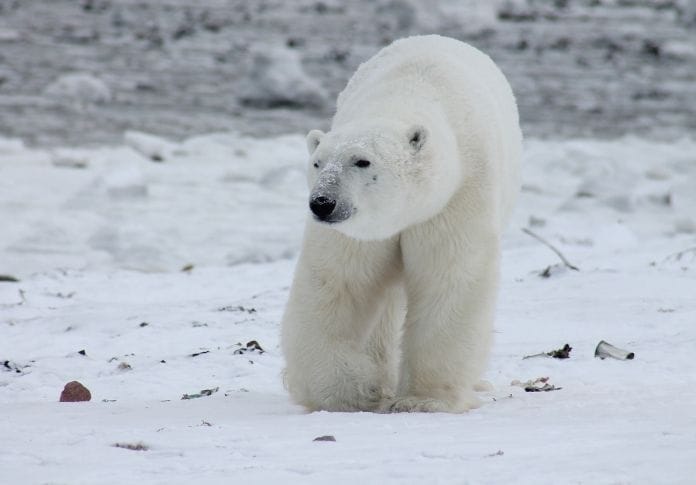
The polar bear is a marine mammal and the largest bear species, with mature male adults ranging from 1.1 to 1.6 m (3’7” to 5’3”) in length, and females ranging from .81 to 1.19 m (2’8” to 3’11”).
Polar bears can swim for hours at a time, which may be useful as they spend approximately half of their life hunting and just 2% of their hunts are successful!
They have a life expectancy of 30 years.
Detailed Overview
| Feature | Description |
| Scientific Name | Ursus maritimus |
| Habitat |
Arctic regions, including sea ice, coastlines, and surrounding waters
|
| Physical Characteristics |
Large carnivorous mammals with thick white fur, black skin, a long neck, and a distinctive elongated snout
|
| Size |
Adult males typically weigh between 900 to 1,600 pounds (410 to 720 kg) and measure 8 to 10 feet (2.4 to 3 meters)
|
| Diet |
Predominantly carnivorous, with a diet consisting mainly of seals, supplemented by fish, birds, and vegetation
|
| Adaptations |
Well-suited for cold environments with insulating fur, large body size, and specialized adaptations for swimming
|
| Conservation Status |
Classified as a vulnerable species due to habitat loss, climate change, and human activities such as hunting
|
| Reproduction |
Females give birth to one to three cubs every two to four years, typically in winter dens made of snow and ice
|
| Behavior |
Solitary animals except during breeding season or when females are accompanied by cubs
|
4 – Shire Horse
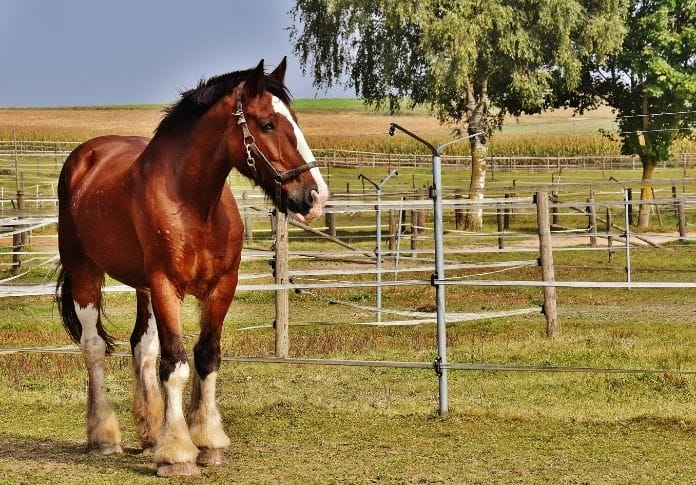
This mythical-looking horse has a long mane, huge hooves, and a black coat with bay or grey markings.
Its withers are about 178m (5’10”) for grown stallions and have a minimum height of 1.73m (5’8″).
On a separate note, the tallest horse presently alive is Zeus, who measures 2.2 meters or 7’2″ tall! Horses live an average of 20 to 30 years.
Related: List of 150+ Name Ideas for a Shire Horse
Detailed Overview
| Characteristic | Description |
| Breed Origin | England |
| Breed Type | Draft Horse |
| Height |
16 to 18 hands (64 to 72 inches, 163 to 183 cm) at the withers
|
| Weight |
1,800 to 2,400 pounds (800 to 1,100 kg)
|
| Coat Color |
Typically black, bay, or gray, but can also be chestnut or roan
|
| Mane and Tail |
Long, flowing mane and tail
|
| Physical Characteristics |
Strong, muscular build with broad chest and powerful hindquarters
|
| Temperament |
Docile and gentle temperament, known for their calm disposition and willingness to work
|
| Historical Use |
Traditionally used for heavy draft work on farms, pulling carts, wagons, and plows
|
| Modern Use |
Today, Shire Horses are used in agriculture, logging, and promotional events. They are also kept as carriage and pleasure horses.
|
| Conservation Status |
Listed as “At Risk” by the Rare Breeds Survival Trust due to declining population numbers
|
| Notable Features |
Known for their impressive size, strength, and feathering on their lower legs
|
5 – White Rhinoceros
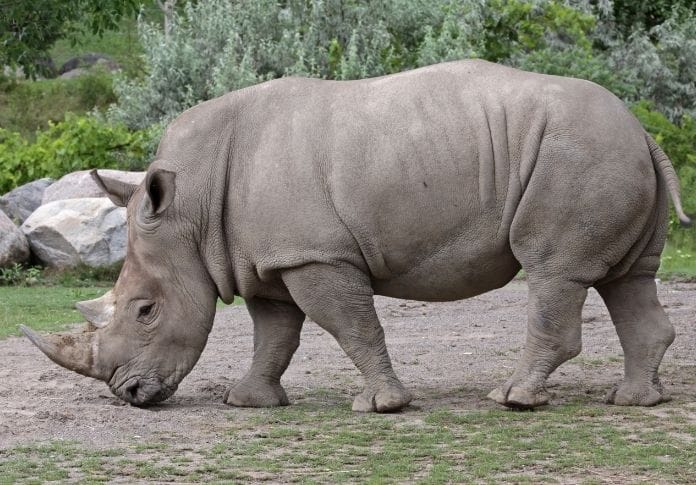
The white rhino is the world’s second-largest land mammal (not tallest), after the African elephant, measuring 1.7-8 meters (5’7-5’11”) in height for males and 1.6-1.78m (5’3″-5’10”) in height for females.
They have long, massive bodies and are known to reach speeds of up to 30 mph.
Detailed Overview
| Aspect | Description |
| Scientific Name |
Ceratotherium simum
|
| Common Name |
White Rhinoceros
|
|
Habitat
|
– Grasslands, savannas, and open woodlands
|
|
– Found in southern Africa, specifically in countries like South Africa, Namibia, Zimbabwe, and Kenya
|
|
|
Physical Description
|
– Large herbivorous mammals
|
|
– Characterized by their square-shaped lips, which are adapted for grazing
|
|
|
– Dull gray or brownish-gray skin, often covered in dried mud for protection from sun and insects
|
|
|
– Prominent horns on the front of the skull, with the larger horn typically measuring longer than the smaller one
|
|
|
Behavior
|
– Generally docile and non-aggressive
|
|
– Often found in small groups called crashes, typically consisting of a dominant male, several females, and offspring
|
|
|
– Communicate through vocalizations, body language, and scent marking
|
|
| Diet |
Grazers that primarily feed on grasses, as well as leaves, branches, and fruits from shrubs and trees
|
|
Reproduction
|
– Polygynous mating system, where dominant males mate with multiple females
|
|
– Gestation period lasts around 16-18 months, resulting in the birth of a single calf
|
|
|
Conservation Status
|
– Classified as “Near Threatened” by the IUCN Red List
|
|
– Threatened by habitat loss, poaching for their horns, and human-wildlife conflict
|
|
|
– Conservation efforts focus on habitat protection, anti-poaching measures, and community engagement
|
6 – Llama

Llamas can stand between 1.7 and 1.8 meters (5’7″ to 11′) when standing upright, with females being somewhat shorter in height.
They live an average of 20 years. They can be stubborn, but they enjoy being the center of attention!
Related: 120 Best Llama Names – Cute & Funny Names for Your Llama
Detailed Overview
| Attribute | Description |
| Scientific Name | Lama glama |
| Family | Camelidae |
| Habitat |
Llamas are native to the Andes Mountains in South America, where they inhabit high-altitude regions up to 14,000 feet (4,300 meters).
|
| Appearance |
Llamas are large, domesticated camelids with long, woolly coats that come in various colors, including white, brown, black, and gray. They have long necks, slender legs, and elongated faces with large, expressive eyes. Llamas are known for their distinctive banana-shaped ears.
|
| Size |
Adult llamas typically stand between 5.5 to 6 feet (1.7 to 1.8 meters) tall at the shoulder and weigh between 280 to 450 pounds (127 to 204 kilograms).
|
| Lifespan |
Llamas have an average lifespan of 15 to 25 years, although some individuals have been known to live into their 30s with proper care.
|
| Behavior |
Llamas are social and herd-oriented animals that live in groups called herds. They are known for their calm and gentle demeanor, although they can exhibit territorial behavior, especially towards other llamas. Llamas are intelligent and curious animals, capable of forming strong bonds with humans and other animals.
|
| Diet |
Llamas are herbivores with a diet primarily consisting of grasses, hay, and other vegetation. They have three-chambered stomachs, which enable them to efficiently digest fibrous plant material. Llamas also require access to fresh water for hydration.
|
| Uses |
Llamas have been domesticated for thousands of years and serve various purposes, including: carrying loads as pack animals, providing fiber for wool production, guarding livestock against predators, participating in therapy and animal-assisted activities, and serving as companion animals. In some regions, llamas are also bred for their meat and milk.
|
| Adaptations |
Llamas have several adaptations that enable them to thrive in their high-altitude mountain habitat, including: thick woolly coats for insulation against cold temperatures, padded feet for walking on rugged terrain, and efficient respiratory and cardiovascular systems for coping with low oxygen levels at high altitudes.
|
| Conservation Status |
Llamas are not considered endangered or threatened species. They are widely distributed across their native range in South America and are actively bred and managed by humans for various purposes. However, habitat loss, disease, and competition with introduced species can pose localized threats to wild populations.
|
7 – Dromedary Camel

The tallest amongst the camel species. This mighty animal is built to last!
Their hump holds a large amount of fat that decomposes to water and energy when other resources are unavailable.
Males reach a height of 1.8-2 meters (5’11” to 6’6″), while females are taller at 1.67-1.88 meters (5’6″ to 6’2″). Their average lifespan is around 40-45 years!
Detailed Overview
| Feature | Description |
| Scientific Name |
Camelus dromedarius
|
| Common Name |
Dromedary Camel
|
| Habitat |
Arid and semi-arid regions of North Africa, the Middle East, and South Asia
|
| Diet |
Herbivorous; primarily feeds on grasses, grains, leaves, and desert vegetation
|
|
Adaptations
|
– Hump: Stores fat for energy during periods of food scarcity
|
|
– Thick coat: Provides insulation from extreme heat and cold
|
|
|
– Large, tough lips: Enable feeding on thorny desert plants
|
|
|
– Ability to conserve water: Can go long periods without drinking water
|
|
|
Behavior
|
– Social animals; typically live in herds led by a dominant male
|
|
– Well-known for their endurance and ability to travel long distances without water
|
|
|
Reproduction
|
– Females (cows) give birth to a single calf after a gestation period of around 12 months
|
|
– Calves are nursed for about 1-2 years before becoming independent
|
|
|
Domestication
|
– Dromedary camels have been domesticated for thousands of years
|
|
– Used for transportation, carrying goods, and as a source of milk, meat, and hides
|
|
| Cultural Significance |
Important cultural symbol in regions where they are found, often revered for their utility and resilience
|
| Conservation Status |
Not listed as endangered or threatened; considered a domesticated species
|
8 – Ostrich
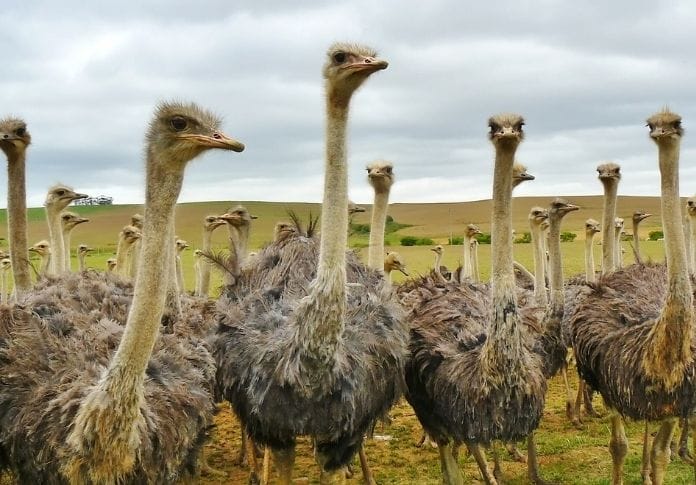
The world’s tallest bird has also one of the longest necks (Great Egrets hold the record for the longest neck), but almost half of its height is in its neck!
Male ostriches can grow around They can grow up to 2.8m (9’2″) tall and females 2m or (6’7″) tall.
The oldest known lifespan for an ostrich is 45 years, so they can live anywhere from 40 to 45 years.
It also holds the world record for the biggest egg, measuring 6 inches (5.8cm) in length!
Detailed Overview
| Characteristic | Description |
| Scientific Name |
Struthio camelus
|
| Habitat |
Native to Africa, found in a variety of habitats including savannas, deserts, and semi-arid regions
|
|
Size
|
– Largest living bird species, with adult males (cock) reaching heights of up to 9 feet (2.7 meters) and weighing between 220-290 pounds (100-130 kilograms)
|
|
– Adult females (hen) are slightly smaller, reaching heights of around 6.6-7.9 feet (2-2.4 meters) and weighing between 150-260 pounds (70-120 kilograms)
|
|
| Appearance |
Large flightless bird with long, powerful legs adapted for running; distinctive long neck and small head; prominent, large eyes; feathers are usually black and white
|
| Diet |
Omnivorous, feeding on a variety of plant matter including seeds, leaves, grasses, and flowers; also consumes insects, small reptiles, and rodents on occasion
|
| Behavior |
Highly social birds, typically living in groups called flocks; known for their speed and ability to run at speeds of up to 43 miles per hour (70 kilometers per hour)
|
|
Reproduction
|
– Females lay eggs in a communal nest, with each female contributing eggs to the nest; incubation period lasts around 40-42 days; male and female share incubation responsibilities
|
|
– Ostrich eggs are the largest of any bird species, with an average size of around 6 inches (15 centimeters) in length and weighing around 3.3 pounds (1.5 kilograms) each
|
|
| Predators |
Main predators include lions, hyenas, cheetahs, and humans; ostrich eggs and chicks are particularly vulnerable to predation
|
| Conservation Status |
Classified as “Least Concern” by the International Union for Conservation of Nature (IUCN); populations are relatively stable, with some localized declines due to habitat loss
|
9 – African Elephant
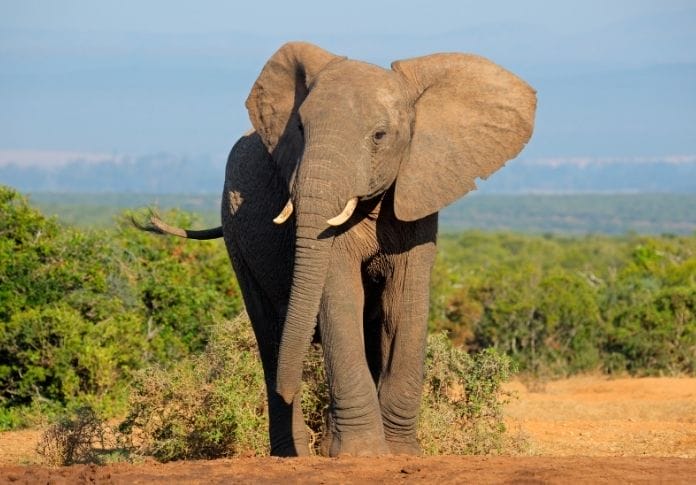
The biggest and heaviest land animal is also the tallest, with males reaching an average of 3.3 meters (10’8″) and females 2.6 meters (8’5″) at shoulder height.
The tallest recorded elephant was a male Asian elephant that stood 1 meter higher than the typical African male (4 meters or 13’1″), weighing in at 11,000 kg!
Related: Over 400 Best Names For Boy, Girl, And Baby Elephants
Detailed Overview
| Feature | Description |
| Scientific Name |
Loxodonta africana (African Bush Elephant) or Loxodonta cyclotis (African Forest Elephant)
|
| Habitat |
African savannas, forests, grasslands, and woodlands
|
|
Size
|
African Bush Elephant: Up to 13 feet tall at the shoulder and weighing up to 14,000 pounds
|
|
African Forest Elephant: Smaller than the Bush Elephant, reaching up to 10 feet tall
|
|
|
Tusk Length
|
African Bush Elephant: Large, curved tusks that can grow up to 10 feet in length
|
|
African Forest Elephant: Shorter tusks compared to the Bush Elephant
|
|
| Social Structure |
Matriarchal groups led by the oldest and most experienced female, consisting of related females and their offspring, while adult males may roam alone or in small bachelor groups
|
| Diet |
Herbivorous, feeding mainly on grasses, leaves, bark, fruits, and roots
|
| Lifespan |
Typically up to 60-70 years in the wild
|
| Conservation Status |
Vulnerable (African Bush Elephant) and Endangered (African Forest Elephant) due to habitat loss, poaching for ivory, and human-wildlife conflict
|
| Behavior |
Highly intelligent and social animals known for their complex communication, including vocalizations, body language, and tactile interactions. They play a crucial role in shaping ecosystems as ecosystem engineers, altering vegetation and creating habitats for other species.
|
| Reproduction |
Gestation period of around 22 months, with females giving birth to a single calf, which is cared for and protected by the entire herd. Calves are dependent on their mothers for several years and learn essential survival skills from the herd.
|
10 – Giraffe
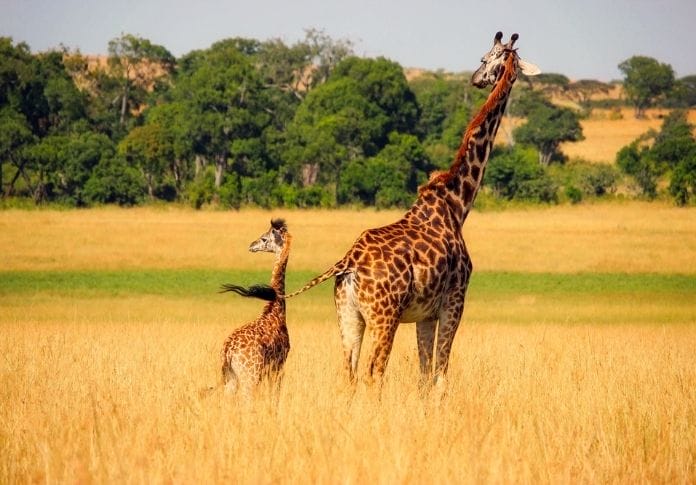
The giraffe is the world’s tallest living animal, with males growing to be about 18 feet tall and females reaching approximately 14 feet.
The tallest giraffe on record is Forest, who lives in Australia and has a height of 5.7m or (18’8″) They typically live 10-15 years in the wild and 20-25 years in captivity.
Related: Best 280+ Giraffe Names (Cute, Famous, Male, Female, Baby Names)
Detailed Overview
| Characteristic | Description |
| Scientific Name |
Giraffa camelopardalis
|
| Family | Giraffidae |
| Habitat |
Savannas, grasslands, open woodlands
|
| Range |
Sub-Saharan Africa
|
| Height |
Up to 5.5 – 6 meters (18 – 20 feet)
|
|
Weight
|
Adult males: 1,200 – 1,400 kg (2,600 – 3,000 lbs)
|
|
Adult females: 800 – 1,200 kg (1,800 – 2,600 lbs)
|
|
| Diet |
Herbivorous; primarily feeds on leaves, twigs, and buds from tall trees, such as acacias
|
| Lifespan |
20 – 25 years in the wild; up to 30 years or more in captivity
|
| Social Structure |
Generally live in loose groups known as towers or herds; no strict social hierarchy
|
|
Reproduction
|
Gestation period: Approximately 15 months
|
|
Typically give birth standing up, with calves dropping to the ground from a height of about 2 meters (6 feet)
|
|
|
Calves can stand and walk within an hour of birth
|
|
| Threats |
Habitat loss, poaching, human-wildlife conflict, predation by lions and hyenas
|
|
Conservation Status
|
Vulnerable (IUCN Red List)
|
|
Giraffe populations have declined by over 40% in the last 30 years, primarily due to habitat loss and illegal hunting
|
Final Words
So there you have it, the magnificent top 10 tallest land animals!
From the undisputed champions, and the giraffes, to the surprisingly tall ostriches and the majestic moose, this list showcases the incredible diversity of life on land.
These giants have evolved remarkable adaptations to overcome the challenges of their height, from powerful hearts to keen eyesight.pen_spark
These massive animals can be found in a variety of habitats around the world, each with its own unique adaptations that help them reach new heights.
- Everything You Need to Know About Silver Grey Dorking Chicken Breed - June 28, 2022
- 5 Reasons Why Cats Tuck Their Paws - June 28, 2022
- 60+ Names Meaning ‘Panda’: The Best Names for Your Baby Panda - June 28, 2022


GIPHY App Key not set. Please check settings